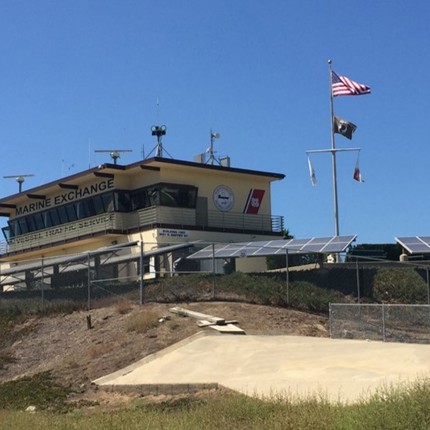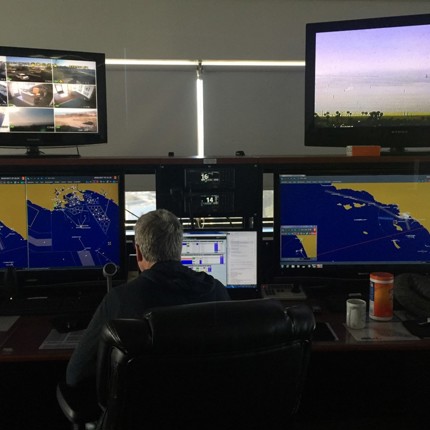
In the busiest container port in the USA, 80 ships and large vessels need to be directed in the right direction every single day.
-
Text:HÅKON SANDLAND
Photo:SHUTTERSTOCK / MARINE EXCHANGE VESSEL TRAFFIC SERVICES
-
Ove Ronny HaraldsenGroup Communication Manager
Surveillance systems from Kongsberg Norcontrol have helped ensure that not a single ship or large vessel has been involved in a collision or run aground since the Marine Exchange Vessel Traffic Services started operations in 1994.
“I’ve seen lots of ports, and many of them are good at safety. But I dare say we’re one of the very best,” says James Kipling (Kip) Louttit.
Kip is Executive Director of Marine Exchange of Southern California (MXSOCAL), the port surveillance unit for Los Angeles and Long Beach, and he amassed many years of service as a Captain in the US Coast Guard. In 2019, his workplace celebrates a quarter of a century without accidents.
“One reason for our success is that everyone involved works very well together. Another is that we have a highly efficient surveillance and communication system. We have great people and great equipment. A century ago, port traffic was directed using binoculars, megaphones, flashlights, flags and chalkboards. It’s safe to say we’ve come a long way since then.”
UNIQUE NEEDS
Surveillance in the ports of Los Angeles and Long Beach works like an airport control tower, but for ships. Twenty Marine Exchange employees work round the clock, together with US Coast Guard watchstanders, to prevent accidents and secure a safe, secure, efficient, and environmentally sound maritime transportation system for the Ports of Los Angeles and Long Beach, and all of Southern California.


And the potential for this is enormous in the busiest ports in the US with 4,500 vessel arrivals and 27,000 vessel movements each year. They comprise the country’s biggest loaded-container port, and they receive some one million cruise passengers annually.
Kongsberg Norcontrol’s maritime and situational awareness solution C-Scope is a useful, necessary assistant. This is the same system used in several of the world’s biggest harbor and coastal areas, such as the English Channel, Singapore and the entire coast of Norway. The system retrieves and merges data from eight radar stations and nine automatic identification sensors into a single image of all of Southern California on one screen—from Morro Bay in the north to the Mexican border in the south.
“We’ve always been at the cutting edge technologically, and we’re keenly focused on using technology to make the tasks of operators as easy as possible. KONGSBERG has been delivering systems like this for 40 years which gives it a strong brand in the market,” says Reidar Olsen, Sales Manager, Kongsberg Norcontrol.
He has been working for MXSOCAL for many years. Los Angeles and Long Beach are now using a third generation version of the system after having it substantially upgraded in 2012. Each year, Kongsberg Norcontrol staff visit California to check and analyze the entire system and make adjustments, update software and provide new training. Special adaptations are also made based on customer needs.
“Each port has a different business model and clearance routines and accepts different types of cargo. The ports are managed differently, which requires the systems to be configured accordingly. We often develop specialized functionality. Los Angeles, for example, has a voluntary environmental requirement for vessel emissions which requires speed limits in a few areas. Our system now monitors whether vessels comply with the speed limits and generates daily reports which are used to provide discounts on port fees for those vessels that are in compliance, Olsen says.
THROUGH A SIDE DOOR
KONGSBERG and Marine Exchange can in part thank the Jacobsen Pilot Service (Long Beach pilot service) for the cooperation they have today. Lockheed Martin has the framework agreement for maritime traffic monitoring centers for major ports in the rest of the US. But one of the leading figures in the local port, Capt. Richard Jacobsen, had two crucial characteristics: Norwegian ancestry and a visionary approach to new technology.
“We got in touch with him during a visit to the US and reached an agreement about installing a test system for port surveillance. The port liked it so much that we got to continue, and Kongsberg Norcontrol has been there ever since,” Reidar Olsen says.

In California, they have never regretted the decision to make room for KONGSBERG.
“We need this system to deal with all the traffic. It has helped us prevent ship collisions and groundings from the outset. It is intuitive, logical and easy to use. It minimizes mouse clicks for key functions, and the systems display high-resolution images of every single vessel. Getting a complete overview of everything that happens in every area of the port enhances safety, security and efficiency. Also, it enables us to conduct operations in an eco-friendly way,” Louttit says.
“The team from Kongsberg Norcontrol is fantastic. They’re are available round the clock all over the world, and they understand our unique port situation with challenging geographical conditions, harsh weather and different rules and processes. All our partners and vessels who visit our port feel the same way. They make our port safe.”
NEW CHALLENGES
How impressive is it to actually be accident-free for 25 years?
“Operating a port area of this size without any accidents whatsoever over so many years is quite an achievement. Something has always been happening somewhere during this period of time. We are very proud to have helped make this possible and to get such good customer feedback,” Olsen says.
The ports of Los Angeles and Long Beach have had to address completely different challenges: pier fires, plane crashes, tsunami, and bomb threats, to name a few. Events of this type cannot be prevented just by having a good port surveillance, but the system helps in the cleanup process and the temporary rerouting of traffic.
Maritime history is filled with collisions and groundings with major consequences. In 1971, two tankers collided under the Golden Gate Bridge spilling 3,000 metric tons of oil into San Francisco Bay. Eighteen years later, the Exxon Valdez, a 300-meter-long oil tanker, ran aground off the coast of Alaska. An oil spill of 50,000 metric tons has a massive, everlasting impact on the lives of fishermen, indigenous peoples and landowners, as well as the flora and fauna in the area.
It is accidents like these that Kip Louttit and the rest of the MXSOCAL want to avoid through good planning, surveillance and communication. And he is convinced they will avoid them for another 25 years.
“If we keep up with developments in the industry and continually improve our systems, I’m sure we’ll manage. Now, however, there will soon be new challenges for ports in the form of new and emerging technology such as remotely operated autonomous ships, and we’ll have to adapt,” Louttit says.
Kongsberg Norcontrol is also preparing for an accident-free future. One principle, however, is key to this development: Everyone involved must continue to get the same situational image.
“It’s paramount that everyone is looking at the same image and knows how to react. But traffic is increasing, ships are getting bigger and congestion in ports is intensifying. In these situations, operators need more decision-making support. We’re spending a lot of time on this now. And then there are the autonomous ships, of course. They will change everything. Once this technology is fully implemented, the on-land infrastructure must to be able to handle it. This will be challenging to traffic surveillance, but we’ll just have to keep up,” Reidar Olsen says.


